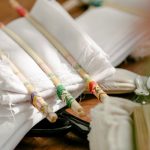You’ll master Arashi Shibori by tightly wrapping damp natural fabric around a pole, securing it with string, then submerging it in dye to create storm-like striped patterns. Controlling wrap tension and dye flow shapes unique textures and color depths. Using fiber-reactive dyes on cotton or silk brings vibrant, lasting results. Visualize dye cascading like waterfalls over folds to enhance patterns. Continue exploring, and you’ll uncover techniques to refine and creatively expand this traditional Japanese art.
Table of Contents
Key Takeaways
- Arashi Shibori involves tightly wrapping damp fabric around a pole to create rain-like patterns through resist dyeing.
- Use natural fibers like cotton or silk and fiber-reactive dyes for vibrant, lasting colors in Arashi Shibori.
- Control pattern density by varying wrap tightness and length, combining short and long wraps for unique textures.
- Dye application requires controlled pouring and rotating the pole to ensure even coverage and dynamic dye flow.
- Visualize dye as flowing water into fabric creases to enhance pattern depth and create movement in the design.
Origins and Cultural Significance of Arashi Shibori
Although Arashi Shibori has gained international popularity as a unique fabric dyeing method, its roots run deep in Japanese history.
Arashi Shibori’s global appeal is matched by its rich heritage rooted deeply in Japan’s history.
When you explore this technique, you’ll find it dates back to the Edo period, where artisans developed it to create intricate patterns resembling rain streaks. The name “Arashi” means storm, reflecting the diagonal lines that mimic rainfall on fabric.
You’ll appreciate how this method embodies Japanese aesthetics, emphasizing nature’s beauty and impermanence.
Traditionally, Arashi Shibori wasn’t just decorative; it carried cultural significance, often used in kimono designs to express seasons or emotions.
As you learn about its origins, you’ll see how this technique connects you to centuries of craftsmanship and cultural expression, making each piece a living story of Japanese heritage.
Materials and Tools Needed for Pole-Wrapping
To start pole-wrapping in Arashi Shibori, you’ll need a few essential materials and tools.
First, select a sturdy, smooth pole or rod, typically made of wood or PVC, about 12 to 18 inches long.
Next, pick a piece of fabric, usually natural fibers like cotton or silk, since they absorb dye well.
You’ll also need rubber bands or string to secure the fabric tightly around the pole.
A set of clamps or clips helps hold the fabric in place during wrapping.
Don’t forget gloves to protect your hands from dye stains and a dye bath prepared with your chosen colors.
Having a spray bottle or squeeze bottle can be handy for applying dye evenly.
Gathering these tools guarantees you’re ready to explore Arashi Shibori’s unique patterns.
Step-by-Step Process of Creating Arashi Shibori Patterns
To create striking Arashi Shibori patterns, you’ll start by preparing your fabric carefully.
Next, you’ll wrap it tightly around a pole to set the foundation for the design.
Finally, you’ll dye the wrapped fabric and unwrap it to reveal the unique patterns formed by the process.
Preparing the Fabric
Before you immerse yourself in creating Arashi Shibori patterns, you’ll need to prepare your fabric carefully to ascertain crisp, vibrant designs. Start by choosing natural fibers like cotton, silk, or linen, as they absorb dye best.
Pre-wash the fabric to remove sizing and oils that might repel dye. Make certain it’s damp but not soaking wet; moisture helps the dye penetrate evenly.
Next, iron the fabric flat to eliminate wrinkles that could distort the pattern. Mark the fabric’s edges lightly if needed to guide your folds.
Finally, cut the fabric to your desired size, leaving extra margin for tying and finishing. Proper preparation sets the foundation for beautiful Arashi Shibori results, so take your time to get it right before moving on.
Wrapping Around Pole
Once your fabric is prepped and ready, you’ll start creating the signature Arashi Shibori pattern by wrapping it tightly around a pole.
Lay the fabric flat, then position the pole diagonally across it. Begin rolling the fabric around the pole firmly and evenly, ensuring no loose folds. As you wrap, keep the tension consistent to form clean, sharp lines in the design.
Once fully wrapped, secure the fabric by tying it tightly with thread or string, binding it in place to maintain the shape. This compression is essential to achieve the characteristic linear patterns.
Take care to evenly space the ties along the pole to create uniform resist points. This step sets the foundation for the unique textures and stripes that define Arashi Shibori.
Dyeing and Unwrapping
Dip the tightly wrapped fabric into your dye bath, making sure it’s fully submerged for an even color absorption.
Keep it immersed for the recommended time, depending on your dye’s strength and the depth of color you want.
Once dyed, gently lift the fabric out and let excess dye drip back into the bath.
Allow it to cool slightly before unwrapping to avoid smudging.
Carefully unwind the fabric from the pole, revealing the intricate diagonal patterns formed by the folds and compression.
Rinse the fabric under cold water to remove any excess dye, then hang it to dry completely.
This process locks in the unique Arashi Shibori design, showcasing the beautiful interplay of light and dark created by your precise pole-wrapping and dyeing technique.
Techniques for Dyeing and Color Selection
Mastering the Arashi Shibori technique means understanding how dye interacts with fabric folds and pleats. When you wrap fabric tightly around a pole and compress it, the dye penetrates unevenly, creating distinctive linear patterns.
Choose fiber-reactive dyes for vibrant, lasting colors that bond well with cotton or silk. You can experiment with single colors for subtle effects or multiple dyes for layered complexity, applying them carefully to avoid muddiness.
Consider the fabric’s base color; lighter shades allow dyes to show clearly, while darker ones create muted results. Also, control immersion time—longer soaks deepen hues, shorter ones leave lighter tones.
Creative Applications and Contemporary Uses
Although Arashi Shibori is rooted in traditional Japanese craftsmanship, you can apply its striking patterns in a variety of modern contexts. You might use it to create unique fashion pieces, from scarves to dresses, adding depth and texture that stand out.
Home décor is another exciting avenue—think cushion covers, curtains, or table linens that bring organic, fluid designs into your living space. Artists and designers also experiment with Arashi Shibori on mixed media projects, combining fabric with painting or digital prints to produce innovative art.
Additionally, you can explore sustainable fashion by upcycling old garments using this technique, breathing new life into your wardrobe. Embracing Arashi Shibori lets you blend tradition with contemporary creativity effortlessly.
Tips for Mastering and Experimenting With Arashi Shibori
To master Arashi Shibori, start by choosing the right fabric—natural fibers like cotton or silk work best.
Experiment with different wrapping techniques around your pole to create unique patterns.
Don’t be afraid to try various dye applications to see how color intensity and placement change your design.
Fabric Selection Tips
Choosing the right fabric is essential when working with Arashi Shibori, as it directly affects the clarity and vibrancy of your patterns. Natural fibers like cotton, silk, and linen absorb dye well, giving you crisp, vivid designs. Avoid synthetic fabrics since they often resist dye or yield dull results. Also, consider fabric weight; lightweight materials create delicate patterns, while heavier ones produce bold effects. Pre-washing your fabric removes sizing and helps dye penetrate evenly.
| Fabric Type | Best For |
|---|---|
| Cotton | Sharp, vibrant patterns |
| Silk | Soft, elegant designs |
| Linen | Textured, natural look |
Wrapping Techniques Variations
Mastering Arashi Shibori involves experimenting with several wrapping techniques that dramatically influence your final pattern.
Start by wrapping your fabric tightly around the pole at different angles—diagonal wraps create dynamic linear patterns, while vertical wraps yield straighter lines.
Vary the tightness; tighter wraps produce sharper, more defined lines, while looser ones give softer, blurred effects.
Try layering multiple wraps in opposite directions to add complexity. You can also adjust the spacing between folds to control pattern density.
Don’t hesitate to combine short and long wraps to produce unique textures.
Each variation affects the fabric’s resistance to dye differently, so play around until you find the look that excites you.
Dye Application Advice
Although wrapping techniques set the foundation, how you apply dye truly brings Arashi Shibori patterns to life. To master this, start with a controlled pour, letting the dye cascade over the fabric’s folds.
Experiment with varying dye concentrations—diluted colors create soft gradients, while rich hues deliver bold contrasts. Remember to rotate the pole during dyeing to guarantee even coverage and dynamic patterns.
Keep these tips in mind:
- Visualize the dye flowing like a waterfall, pooling in creases for unique textures.
- Imagine the fabric spiraling tightly around the pole, guiding dye paths like rivers.
- Think about how light and shadow emphasize ridges and valleys, enhancing pattern depth.
Frequently Asked Questions
How Does Arashi Shibori Compare to Other Shibori Techniques?
You’ll find Arashi Shibori creates diagonal, storm-like patterns by wrapping fabric around a pole, unlike other Shibori techniques that use folding or stitching. It’s unique, producing crisp, linear designs with dynamic texture and depth.
Can Arashi Shibori Be Done With Synthetic Fabrics?
You can use Arashi Shibori with synthetic fabrics, but you’ll need to adjust dye types and temperatures. You’ll experiment with heat, you’ll experiment with dye, and you’ll find the perfect balance for vibrant results.
What Are the Environmental Impacts of the Dyeing Process?
You’ll find dyeing often uses a lot of water and chemicals, which can harm ecosystems if not managed properly. Choosing natural dyes and eco-friendly practices helps reduce pollution and conserve resources, protecting the environment.
How Long Does the Entire Arashi Shibori Process Typically Take?
Think of it like watching a flower bloom—it usually takes you several hours, from prepping fabric to dyeing and unwrapping. Depending on complexity, the entire process can last anywhere from 4 to 8 hours.
Are There Any Health Risks Associated With the Dyes Used?
You might face skin irritation or allergic reactions if you handle dyes without gloves. Always work in a well-ventilated area and choose natural or low-toxicity dyes to minimize health risks during the dyeing process.
- A Deep Dive Into Arashi Shibori (Pole-Wrapping) Technique - July 13, 2025
- Resist Dyeing Techniques Beyond Tie-Dye: Batik and Shibori - July 13, 2025
- How to Set Your Tie-Dye so It Doesn’t Fade - July 13, 2025






